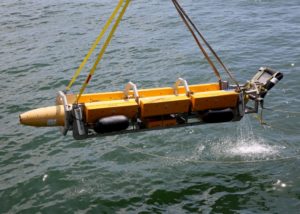General Dynamics’ [GD] Mission Systems business unit announced last Thursday it delivered the first Knifefish surface mine countermeasure unmanned underwater vehicle (UUV) system to the Navy.
The company told Defense Daily
delivery occurred on February 26 and noted it was under a contract awarded in August 2019.

In 2019 the Knifefish successfully achieved a Milestone C approval and subsequently won a $44.6 million modification for five low-rate initial production (LRIP) systems. (Defense Daily, Aug. 26, 2019).
The Knifefish is designed to be deployed from Littoral Combat Ships (LCS), shore, or vessels of opportunity to find and classify buried, bottom and volume mines in high-clutter environments. It is one of the main elements of the LCS Mine Countermeasures Mission (MCM)Package.
Each system consists of two UUVs along with support systems and equipment. The Knifefish uses low-frequency broadband sonar and automated target recognition software developed by the Naval Research laboratory. Combined, this acts like an off-board sensor while the LCS remains outside a minefield perimeter. Therefore the LRIP contract calls for 10 total UUVs to be delivered.
At the time of the LRIP award, the Navy said those units “will provide the initial systems for the Navy to test and operate.”
A full rate production decision is expected in 2022 after testing of the LRIP units. The Navy plans to eventually procure 30 systems total, divided into 24 as part of the LCS MCM mission packages and six deployed on vessels of opportunity.
“Together with the U. S. Navy’s Program Executive Office for Unmanned and Small Combatants, our Knifefish team has worked to deliver critical mine countermeasure mission capabilities to protect our Sailors,” Carlo Zaffanella, vice president and general manager at General Dynamics Mission Systems, said in a statement.
“We designed Knifefish using an open architecture concept that can be quickly and efficiently modified to accommodate a wide range of missions,” he added.
The Knifefish UUVs are based on the GD Bluefin Robotics Bluefin-21 deep-water autonomous undersea vehicle.
In November, the Navy posted a Request For Information to determine if sources exist to satisfy expected program requirements of the Knifefish system. The notice said the effort seeks to assess industry’s ability to fabricate, assemble, test and deliver Knifefish systems to designs provided by the government (Defense Daily, Nov. 6, 2020).
Last September, Program Executive Officer for Unmanned and Small Combatants Rear Adm. Casey Moton said in 2021 the Navy will test the Knifefish system Block 1 along with other elements of the LCS MCM Mission Package. Once the elements are tested individually, they will be tested at full package-level testing as a demonstration (Defense Daily, Oct. 1, 2020).